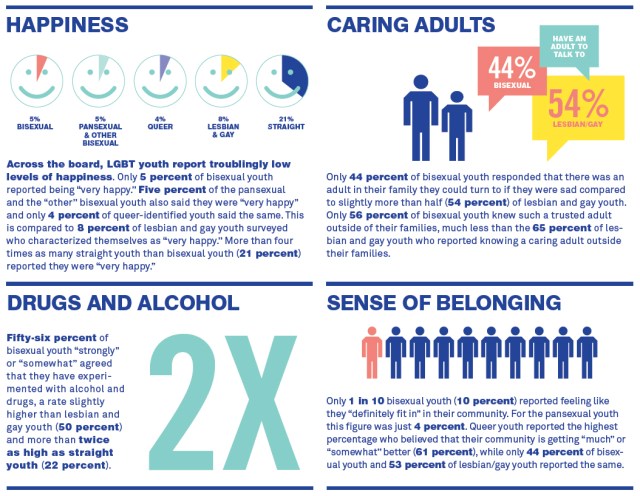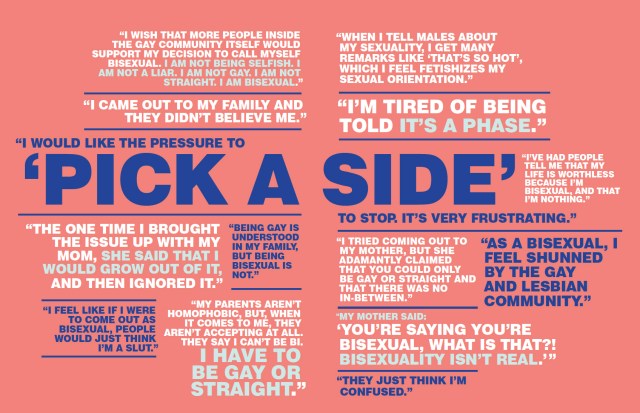Bisexuals aged 13-17 experience lower levels of happiness, higher rates of alcohol and drug use, and lower levels of social and family acceptance and support than their straight, gay and lesbian peers, according to a new report from the Human Rights Commission in partnership with BiNet USA, Bisexual Resource Center, and Bisexual Organization Project.
The report, out today, uses data from a 2012 HRC survey of 10,030 LGBTQ youth. In that survey, 3,808 youth identified as bisexual, 354 identified as queer, 671 identified as pansexual, and 109 identified as something else other than specifically gay or lesbian (e.g. heteroflexible) — that’s almost 40% of LGBTQ youth who identify as non-monosexual. The report revealed strong trends that bisexual young people feel less accepted in their identities than their straight, gay and lesbian counterparts. Of bisexual youth, 44% reported having a trusted adult family member to talk to, compared to 54% of gay and lesbian youth. Only 10% of bi youth and 4% of pansexual youth reported feeling like they “definitely fit in” in their communities. Bi youth were less likely than their gay and lesbian peers to know whether there was a Gay Straight Alliance at school or an LGBT service community center in their area.

via HRC
Interestingly, queer youth reported higher rates of optimism, outness and community acceptance in some areas than bisexuals.
The report — which is beautifully and accessibly presented — should be a wake up call to LGBTQ service providers, advocates, community members and allies who aren’t aware of the challenges bisexual youth face and just how big a proportion they are are of the community, said Ellen Kahn, Director of the HRC’S Children, Youth and Family Project.
“Organizations that serve the LGBTQ community need to be able to think differently about what kinds of services might address some unique needs of the bisexual part of our community,” Kahn said. “If young people are telling us in our survey they don’t feel connected to LGBT centers or don’t know about resources, what do we need to be doing in our outreach materials to reach those people?”
The numbers paint a bleak picture, but it’s important that they exist. Bisexuals are very underrepresented in research related to the LGBTQ community, and we’re often rolled into lesbian and gay numbers and programs despite our very specific challenges and needs. The HRC has received criticism in the past for contributing to the erasure of the bi community, so it makes an impact for them to ally with prominent bisexual organizations to lift up the voices of bi people. Today is Bisexual Visibility Day and part of the first ever Bisexual Awareness Week, and it’s an opportunity to take a hard look at the needs of the bi community and how we can all serve and support it better.
Yesterday, the LGBT Movement Advancement Project released a report highlighting the health, violence, income and other disparities bisexual people experience. The timing of the two reports is impactful, Kahn said.
“We’re seeing some of the outcomes in adulthood that bi people are experiencing, and with this data from young people we have a chance to try to chisel away at some of the stigmatization so that the next generation of bi adults will fare better,” she said.

Youth can speak for themselves about their identities and needs. via HRC
Bisexual youth have lower rates of being out as bi to everyone in their lives, according to the report. Kristin Russo, co-founder of Everyone Is Gay, said she originally came out to her parents as bisexual but later came out again as lesbian because she felt her parents weren’t able to understand bisexuality as a valid identity.
“What it did was close the conversation and allowed my mom to only have deep understandings of what it means to be gay and what it means to be straight,” she said. “If I had come out as bisexual we would have had more of a dialogue about sexuality.”
Everyone Is Gay gets a lot of questions from bi young people who struggle with similar fears about whether people will believe that they are something other than gay, lesbian or straight. This data creates a new opportunity to look at the messages youth are receiving about bisexuality from the media and their parents, peers and communities. One simple way to do that? “Especially with young people, we need to ask open ended questions,” Kahn said. “Young people have said to us so many times ‘I don’t want to check a box’ but we keep putting forms in front of them with boxes.”
Resolving the stigmas and social and policy pressures that hurt bisexual youth is more than a numbers game. But with powerful, clear data like this, bi advocates have an important new tool to pursue inclusion, and educators, parents and lgbtq service providers have a new resource to begin to understand that bisexual youth exist and need someone to start listening.



When I was young, I had a family that was very gay-friendly but not very bi-friendly. It’s interesting to see that experience reflected many times in the quotes from young people!
Thank you for this!
audrey, thanks so much for putting this together!
“Pick a side” I really wish To Jesus it was that easy. I really wish that i would change and fit unto the normal category. I really wish that everything was black and white and there were no sexuality like mine. These were the wishes i had when i was so in denial and miserable that i couldn’t navigate and demand for my soul and body to decide whether i was Gay or Straight. I was growing up having romantic feelings for the same sex and opposite sex. I grew up thinking that i was abnormal. I had to choose between Gay or straight. I remember that i used to ride the school service and along the way i’d sometimes repetitively ask myself the question “Am i Gay or straight?” in my head. The feeling of bisexuality was so familiar yet so foreign.
I knew what Gay means because i see celebrities who are Gay on tv. One of my father’s brother is Gay. However, I had not heard of the word Bisexual and i didn’t know any person who identified as Bisexual.
Which created more questions in my mind. Question like “I see the girl and the boy i have a crush on, Why do i like her and i like him too?, Why am i this weird?, Do i have a congenital disorder?, What kind of doctor should i go to?, If i pray every night and cry to God and memorize prayers in the bible, Will it go away?, If i avoid hanging out with the girl and the boy i have a crush on, Will it go away?, Why can’t this feeling just stop?”
I was dying for answers. One random unexpected day, I bumped into a video of two women kissing(l word) and i nervously checked it out. I consciously liked it and hesitantly downloaded it from piratebay. There it goes. The feelings were there but i didn’t know what’s the name for it. Season 2 of the l word made the bulb in my head light up. I screamed a little inside of me and said, That’s the word i was looking for! That’s me! Hell yes! Everything started to make a lot of sense. Thanks the L word and Thanks to the people who kindly writes an article like this ;)
Closeted to my parents (I think my dad has worked it out, though, and I don’t think he’s biphobic like my mum) but would be properly out if I was monosexual. I live a double life and it’s exhausting. I’m out to absolutely everyone in my life except my parents, who have never even met anyone I’ve ever dated.
Lesbians exist, straight girls exist but apparently I don’t.
Thanks for this. Very bleak but very important information that needs to be further disseminated.
Unfortunately, the report does not separate findings on race and I feel like this does not give the complete pictures of what is happening. The HRC’s report on Latino LGBT Youth (http://www.hrc.org/youth/latino-youth#.VCJbTpSSxOI), which is based on the same set of data says, for example, that only 1/3 of Latino LGBT youth have a trusted family member they can talk to – this is significantly lower than white LGBT youth, but also significantly lower than the statistic for all bisexual youth (which is 45%). Only 60-70% of non-monosexual youth are white, I think it’s important to see these statistics in the context of race.
I can remember the “sense of belonging” aspect playing a big part in my own depression and sense of isolation as a teen. If I’m being completely honest, it still does, but it’s a lot easier to frame those feelings and accept them as an adult.
This makes me sad.
I found this very interesting and so true. It is tough being bi and I look up to people who are definite about their sexuality.